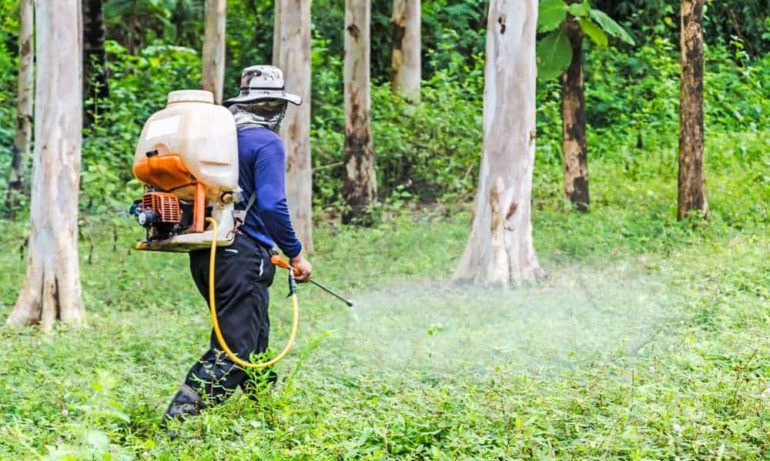Food Tank interviewed Jules Pretty, a professor of environment and society at the University of Essex and lead author of a paper on integrated pest management in Africa and Asia.
The overall message: Sustainable intensification (SI) has been proposed as a potential solution to improving agricultural productivity while minimizing harmful effects of agriculture on the natural environment. Integrated pest management (IPM) could be a key method to achieve SI in Asia and Africa, but has been plagued by low adoption rates. Support from the public sector could improve adoption at low cost to ameliorate farmer livelihoods and mitigate negative externalities from excessive pesticide use.
The research: This study was uniquely comprehensive. A review of 85 IPM projects in 24 Asian and African countries found that the majority of projects simultaneously decreased pesticide use and increased yields. In 35 of the 115 datasets from the projects, pesticide use actually fell to zero. A key aspect of the success of many of the projects and programs was training, typically referred to as Farmer Field Schools (FFS).
Food Tank (FT): What are two key points of your paper, in layman’s terms? Why is your review relevant to the transition to sustainable agriculture?
Jules Pretty (JP): First, pesticide use continues to grow worldwide, and represents significant externalized costs to human health and ecosystem services. Although each compound has different properties, some being safer than others, overall pesticide use is hazardous to human health and the health of the environment.
Second, through innovative use of knowledge-building mechanisms such as FFS, it is possible to build farmers’ knowledge and social capital, such that they can redesign agroecosystems to be more productive while lowering the use of pesticides.
FT: Can you explain the importance of FFS to the success of IPM?
JP: FFS are experiential learning mechanisms that last a whole season. They allow farmers to test their own fields and run experiments to challenge received wisdoms. For example, when rice is damaged by herbivorous pests in the first 40 days after germination, there is no actual impact on yields, even if the crops look very ragged from insect damage. It is hard for farmers to believe this unless they experiment themselves. Once they do, they can cut insecticide use substantially.
FFS aren’t the only way to provide learning opportunities, but they do have the additional advantage of forming social capital by bringing together interested stakeholders in local communities. Other future learning opportunities could include mobile technology for farmers.
FT: In the paper, you conclude that IPM adoption could be improved in Asia and Africa, at low cost, through the support of public policy. How do you envision feasible policies that would explicitly support IPM for smallholder farmers rather than banning active ingredients?
JP: Many countries now provide explicit support to approaches like FFS through extension systems, seeking to form social capital and mechanisms for farmer learning. For example, in Bangladesh, where pesticide use rose about 489 percent over a 20-year period, FFS were used to implement a simple pheromone insect trap. Through this intervention, insecticide use fell from 15 sprays per season to zero, while yields rose 40–130 percent. 650,000 farmers have graduated from FFS in Bangladesh due to public support.
FT: Criticisms of IPM have included fears about costs and about the knowledge-intensive nature of IPM. We found your paper’s emphasis of FFS to be extremely interesting because the approach addressed both of these criticisms simultaneously. However, some might contend that upfront costs are excessive and short-term impacts insufficient to drive a transition to IPM. How would you respond to such a criticism and describe a politically feasible transition that takes farmer perspectives into account?
JP: There is only really one paper that has criticized FFS in this way, and it was flawed. If we want to build natural capital, social capital, and human capital, then we must spend resources to do this. Building such capitals safeguards the future of food and agriculture. It is a good investment, especially for developing nations, and also a good way for affluent countries to provide development assistance effectively.
There is also the argument of accounting for the full costs of pesticides. By preventing environmental harm through lowering the use of pesticides, we are investing in human health and conservation to avoid paying these externalized costs in the future. As our paper shows, this doesn’t have to come at the expense of farm productivity! Sticking with the example of Bangladesh, FFS have been shown to create US$4 of benefits for every US$1 spent on the program there.
FT: You also mention in the paper that half of pesticide use in Asia and Africa may be excessive, such that yields could be maintained with lower pesticide inputs. A critic might therefore contend that reduction in excessive use, without a transition to IPM, may be sufficient to reduce negative externalities, while costing less upfront and requiring less training through FFS. How would you respond to such a criticism and advocate for adoption of IPM for the long-term, beyond the reduction of excessive pesticide use?
JP: This is an interesting point—some costs could be saved. But by focusing solely on reducing overall use, without implementing IPM as an alternative, would miss the substantial advantages that flow from system redesign. The example of push-pull (vutu sukumu) in East Africa shows the potential for IPM to create social capital through FFS. By producing more food without harm to the environment, farmers contribute to greener economies. These new economies offer many novel opportunities for businesses and help to grow GDP in a sustainable way. It’s important to look at the problems of the whole system rather than focus on just one input to a system that’s not currently working.













